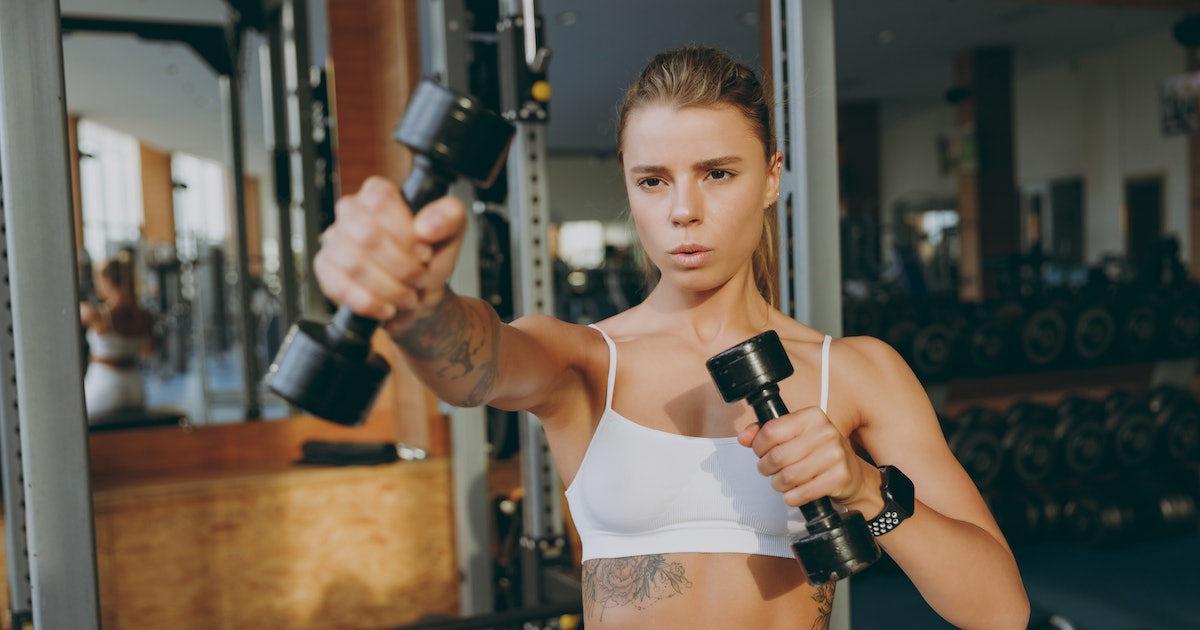The subsequent time you do a bicep curl, decrease right into a squat, or jog on the treadmill, attempt to concentrate to the best way you breathe. If you naturally fall right into a sample the place you maintain your breath or take brief gasps of air, you’ll positively profit from making just a few modifications to make sure you’re respiration correctly throughout train.
Of course, exercising is supposed to problem your respiration. As you progress, your lungs work more durable to usher in oxygen and take away carbon dioxide whereas your coronary heart pumps quicker to flow into oxygen to no matter muscle groups you’re utilizing. As all of this occurs, your breathing increases from an average of 15 times a minute at rest to 40-60 times a minute during exercise. But there are methods to get a greater deal with on this demand. According to Dr. Robert W. Berghorn, Jr., DPT, ATC, USAW, a physician of bodily remedy and proprietor of Ascent Physical Therapy, practising breath control during a workout has two advantages. “It allows you to get adequate blood supply to your brain in regular intervals, and it also provides a greater level of support and stability throughout your body and core muscles,” he tells Bustle.
Getting sufficient oxygen to your mind and muscle groups means you’ll have the ability to perform better for longer, Berghorn says, particularly in comparison with if you don’t take full inhales and exhales. A correct breath also can assist your core muscle groups assist you. “The diaphragm, which allows you to breathe, is a muscle and is one component of your core musculature,” Berghorn explains. “By inhaling you are creating pressure within your abdominal cavity that — along with your hips, abdominal, and spinal muscles — provides great support and stability so you can move safely and with maximum effectiveness.”
If you’re not respiration correctly when doing cardio or strength training, you gained’t have the ability to take advantage of out of your exercise, says Joey Thurman, CES, CPT, FNS, a celeb coach with health platform kuudose. Not solely that, however shallow, uneven breaths could make you’re feeling dizzy or lightheaded resulting from hyperventilation, he says. To keep away from that, learn on for tips on find out how to effectively breathe throughout train.
How To Breathe When Strength Training
If you have a tendency to carry your breath whereas lifting weights or doing power work, hear up. The rule of thumb is to exhale as you carry a weight and inhale as you decrease it again down, Thurman says. It’s all within the title of getting essentially the most oxygenated bang on your buck. Fun truth: That’s why you at all times see seasoned weightlifters exhaling with goal as they energy via a transfer.
There is a stage of coordination that comes with the sort of purposeful respiration, Berghorn notes, however when you get the hold of it you possibly can apply it to all kinds of workouts. “Let’s take a squat for example,” he says. “You’ll want to take a deep inhale on the way down, being at max inhale at the bottom of the squat. From there, you’ll breathe out as you push into the ground to stand up.”
Pursing your lips as you breathe out can also be key. “Breathing out of your mouth through pursed lips allows you to better retain oxygen in your lungs, allowing a greater amount of oxygen transfer to your body and muscles for better function with each breath,” Berghorn explains. It might really feel like overkill, but it surely’s positively value it.
How To Breathe During Cardio
You must also just remember to’re respiration out and in as totally as attainable as you run, row, or glide on an elliptical. For cardio, Thurman recommends inhaling deeply via your nostril and out via your mouth. “This helps to warm and moisten the air going into your lungs,” he says, which makes for a extra comfy exercise.
Keep a snug sample going as finest you possibly can, ensuring to purse your lips for that candy, candy oxygen switch. You may finally change to respiration out and in via your mouth as your routine turns into extra intense, and that’s OK. If you begin to breathe in via your mouth, Berghorn recommends maintaining control of your respiratory rate by making it as regular and measured as attainable.
If you’re feeling drained, lightheaded, or dizzy throughout your exercise, it might imply you’re respiration too quick or too gradual. If so, take a break and get again to a gentle respiration sample, after which see how you’re feeling. As Thurman says, “By following these simple tips, you can make sure you’re getting the most out of your workout and avoid any potential health risks.”
Studies referenced:
Bahenský, P. (2021). Impact of a Breathing Intervention on Engagement of Abdominal, Thoracic, and Subclavian Musculature throughout Exercise, a Randomized Trial. J Clin Med. doi: 10.3390/jcm10163514.
Querido, JS. (2007). Regulation of cerebral blood movement throughout train. Sports Med. doi: 10.2165/00007256-200737090-00002.
Sakhaei, S. (2018). The Impact of Pursed-lips Breathing Maneuver on Cardiac, Respiratory, and Oxygenation Parameters in COPD Patients. Open Access Maced J Med Sci. doi: 10.3889/oamjms.2018.407.
Your lungs and train. Breathe (Sheff). 2016 Mar;12(1):97-100. doi: 10.1183/20734735.ELF121. PMID: 27066145; PMCID: PMC4818249.
Sources:
Joey Thurman, CES CPT FNS, celeb coach with kuudose
Dr. Robert W. Berghorn, Jr., DPT, ATC, USAW, physician of bodily remedy proprietor of Ascent Physical Therapy

